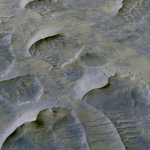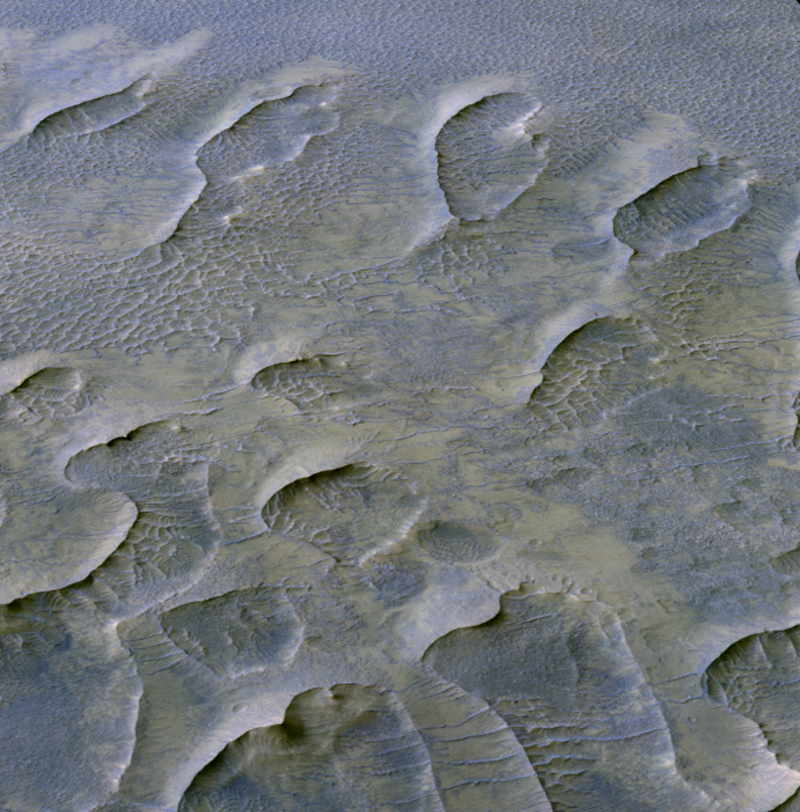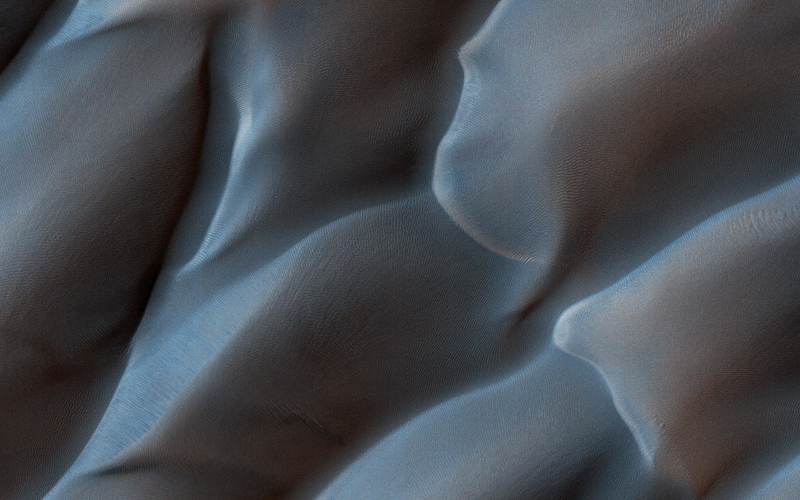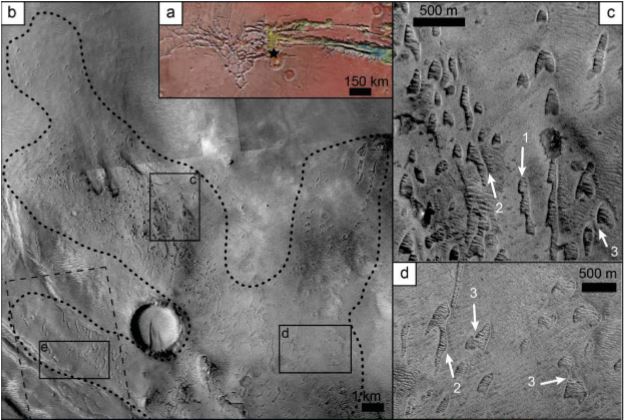

Here is a region on Mars where sand dunes have been compacted over time into solid rock. This image, taken by the HiRISE high-resolution camera aboard NASA’s Mars Reconnaissance Orbiter, zooms in on the now-solid sand dunes in Melas Chasma, part of the extensive Valles Marineris canyon network on the red planet. Image via NASA/ JPL/ Planetary Science Institute.
On October 5, 2020, a team of scientists announced the discovery of a group of one-billion-year-old Martian sand dunes in the planet’s Valles Marineris region. This rare find of paleo-dunes led scientists to a second big discovery. That is, climate, atmospheric pressure and landscape evolution on Mars have remained relatively consistent over the past billion years.
The research – led by planetary geologist Matthew Chojnacki at the Planetary Science Institute in Tucson, Arizona – was published in a paper in the peer-reviewed Journal of Geophysical Research Planets. A statement from Chojnacki and his colleagues explained that extensive mapping of sedimentary rock deposits within Melas Chasma – the widest segment of the Valles Marineris canyon system on Mars – provided the evidence needed to date the dune fields and to form an understanding, not only of what Mars was like 1 billion years ago, but of how the red planet’s climate has evolved over time. They said that the evidence included both lithification – the process by which loose sediments are compacted into solid rock – and the burial of those dunes by wind over time.
Through this work, they said, they learned that these unique paleo-dunes on Mars had been untouched by the same sorts of geologic forces – such as the shifting of great land plates (plate tectonics) and erosion by wind and water – that so altered Earth’s surface over the past billion years.

Matthew Chojnacki is a research scientist at the Planetary Science Institute, headquartered in Tucson, Arizona. On October 5, 2020, Chojnacki published a paper detailing the discovery of preserved billion-year-old sand dunes on Mars, which are helping scientists to unravel the mysteries of the red planet’s geologic and climatic history. Image via Planetary Science Institute.
Chojnacki said in the statement that the condition of the Mars sand dunes was an indicator of well-preserved “old” age, in comparison to Earth dunes:
We identified and mapped extensive dune fields in the canyons of Valles Marineris which show clear evidence for lithification and burial. This level of preservation is rare for terrestrial [Earthly] sand dunes due to ongoing erosion and tectonics.
Chojnacki admitted that analyzing and dating dune fields on Mars is no easy task, as all of the scientific work has to be done from afar. He told EarthSky that one challenge scientists faced in dating the duneforms was what they didn’t have: physical samples. But, he noted, the absence of samples didn’t stop the team from achieving significant results:
Dating of planetary surfaces is extremely challenging without physical samples. Planetary scientists often use the accumulated craters on the surface compared with the anticipated flux of impactors to estimate a surface age (older surfaces accumulate more craters). These deposits did not show many craters, indicating they must be relatively young. We also looked at erosion rates or how quickly landforms are worn away by wind and other factors. Using these two techniques we estimate these dune deposits to not be older than a few billion years (or they would’ve accumulated more craters) but not younger than about one billion years (or erosion would have erased them from the surface).

A closeup of contemporary, active sand dunes on the surface of Mars, taken by the HiRISE camera aboard the Mars Reconnaissance Orbiter. HiRISE is capable of zooming in to see objects on the Martian surface as small as a table, and in this image, clearly captures the morphology, or form, of active sand dunes, including wind patterns and wind direction that have pushed and pulled loose sand to create piles and patterns. Image via NASA/ JPL-Caltech/ University of Arizona.
Chojnacki said that the aeolian processes impacting these particular dunes – that is, the ways in which sediments on this part of Mars’ landscape might have been eroded or moved by wind – revealed significant information about the evolution of wind and atmospheric pressure on Mars over time. He said:
We can see that modern sand dunes in the area are oriented in very similar directions to those in the rock record. This indicates the major wind directions that are responsible for the dunes’ shape have not changed substantially over time. We also see very similarly sized and spaced sand dunes from the two time periods. This may indicate the atmospheric pressure wasn’t significantly different.
In other words, the Mars of a billion years ago was pretty similar to the Mars of today, at least as far as wind patterns and atmospheric pressures are concerned.
The data from the study, collected using instruments aboard NASA’s Mars Reconnaissance Orbiter and Mars Odyssey Orbiter, are helping scientists to better understand the geologic history of Mars, and how it differs from that of Earth. Chojnacki said:
Sand dunes are migrating, driven by wind on Mars just as on Earth. The sand that makes up terrestrial dunes often can be converted into rock, but often factors like water or vegetation prevent the full shape of the dune to be preserved. We found groups of sand dunes on the surface of Valles Marineris, Mars, that were also turned into stone sometime in the past, but many of these retained their shape. The fact that sand dunes once migrated across the Martian surface and are now preserved in the rock record tells us something about the conditions that led to their preservation and how those differ from that of the Earth.
Similar to those that form on Earth, contemporary Martian sand dunes are not uncommon on the red planet, a desert landscape with many similarities to the deserts found on Earth, although much colder. Ancient duneforms, on the other hand, have until recently been a rare find on Mars, and are most often uncovered as eroded pits.

“Ghost dunes” in Noctis Labyrinthus on Mars. The crescent-shaped pits are the remains of active sand dunes from billions of years ago. Image via Mackenzie Day/ David Catling/ AGU.
In April 2018, EarthSky reported the discovery of ghost dunes – pit-like depressions left behind when dunes erode away – by scientists at the NASA Astrobiology Institute. Uncovered in the Noctis Labyrinthus region, west of Valles Marineris, these ghost dunes proved that wind patterns on Mars changed over time, shaping and reshaping the landscape, similar to what wind patterns on Earth do in places like the Sahara Desert.
While there are marked similarities between Mars and Earth – including the wind-driven formation of sand dunes – the processes of surface erosion and landscape evolution differ greatly. That’s good news for scientists studying the geologic and climatic history of Mars. Chojnacki commented:
Water and tectonics that constantly reshape the surface of Earth are not currently a factor on Mars. Thus there’s an opportunity to learn from the geologic record of the red planet. The ancient dune fields found within Valles Marineris – with their complex variety of landform shapes, degree of preservation, and context – reveal the richness of regional geology. These results inform us that wind-driven sand transport, deposition, and lithification have occurred throughout much of Mars’ recent history and illustrate how landscape evolution there greatly differs compared with that of Earth.
Bottom Line: The discovery of near-perfectly preserved billion-year-old sand dunes on Mars has revealed big news to scientists about the geologic history of the red planet: its climate, atmospheric pressure and landscape evolution have remained fairly consistent all this time.
Via Planetary Science Institute
from EarthSky https://ift.tt/2GBZZBN


Here is a region on Mars where sand dunes have been compacted over time into solid rock. This image, taken by the HiRISE high-resolution camera aboard NASA’s Mars Reconnaissance Orbiter, zooms in on the now-solid sand dunes in Melas Chasma, part of the extensive Valles Marineris canyon network on the red planet. Image via NASA/ JPL/ Planetary Science Institute.
On October 5, 2020, a team of scientists announced the discovery of a group of one-billion-year-old Martian sand dunes in the planet’s Valles Marineris region. This rare find of paleo-dunes led scientists to a second big discovery. That is, climate, atmospheric pressure and landscape evolution on Mars have remained relatively consistent over the past billion years.
The research – led by planetary geologist Matthew Chojnacki at the Planetary Science Institute in Tucson, Arizona – was published in a paper in the peer-reviewed Journal of Geophysical Research Planets. A statement from Chojnacki and his colleagues explained that extensive mapping of sedimentary rock deposits within Melas Chasma – the widest segment of the Valles Marineris canyon system on Mars – provided the evidence needed to date the dune fields and to form an understanding, not only of what Mars was like 1 billion years ago, but of how the red planet’s climate has evolved over time. They said that the evidence included both lithification – the process by which loose sediments are compacted into solid rock – and the burial of those dunes by wind over time.
Through this work, they said, they learned that these unique paleo-dunes on Mars had been untouched by the same sorts of geologic forces – such as the shifting of great land plates (plate tectonics) and erosion by wind and water – that so altered Earth’s surface over the past billion years.

Matthew Chojnacki is a research scientist at the Planetary Science Institute, headquartered in Tucson, Arizona. On October 5, 2020, Chojnacki published a paper detailing the discovery of preserved billion-year-old sand dunes on Mars, which are helping scientists to unravel the mysteries of the red planet’s geologic and climatic history. Image via Planetary Science Institute.
Chojnacki said in the statement that the condition of the Mars sand dunes was an indicator of well-preserved “old” age, in comparison to Earth dunes:
We identified and mapped extensive dune fields in the canyons of Valles Marineris which show clear evidence for lithification and burial. This level of preservation is rare for terrestrial [Earthly] sand dunes due to ongoing erosion and tectonics.
Chojnacki admitted that analyzing and dating dune fields on Mars is no easy task, as all of the scientific work has to be done from afar. He told EarthSky that one challenge scientists faced in dating the duneforms was what they didn’t have: physical samples. But, he noted, the absence of samples didn’t stop the team from achieving significant results:
Dating of planetary surfaces is extremely challenging without physical samples. Planetary scientists often use the accumulated craters on the surface compared with the anticipated flux of impactors to estimate a surface age (older surfaces accumulate more craters). These deposits did not show many craters, indicating they must be relatively young. We also looked at erosion rates or how quickly landforms are worn away by wind and other factors. Using these two techniques we estimate these dune deposits to not be older than a few billion years (or they would’ve accumulated more craters) but not younger than about one billion years (or erosion would have erased them from the surface).

A closeup of contemporary, active sand dunes on the surface of Mars, taken by the HiRISE camera aboard the Mars Reconnaissance Orbiter. HiRISE is capable of zooming in to see objects on the Martian surface as small as a table, and in this image, clearly captures the morphology, or form, of active sand dunes, including wind patterns and wind direction that have pushed and pulled loose sand to create piles and patterns. Image via NASA/ JPL-Caltech/ University of Arizona.
Chojnacki said that the aeolian processes impacting these particular dunes – that is, the ways in which sediments on this part of Mars’ landscape might have been eroded or moved by wind – revealed significant information about the evolution of wind and atmospheric pressure on Mars over time. He said:
We can see that modern sand dunes in the area are oriented in very similar directions to those in the rock record. This indicates the major wind directions that are responsible for the dunes’ shape have not changed substantially over time. We also see very similarly sized and spaced sand dunes from the two time periods. This may indicate the atmospheric pressure wasn’t significantly different.
In other words, the Mars of a billion years ago was pretty similar to the Mars of today, at least as far as wind patterns and atmospheric pressures are concerned.
The data from the study, collected using instruments aboard NASA’s Mars Reconnaissance Orbiter and Mars Odyssey Orbiter, are helping scientists to better understand the geologic history of Mars, and how it differs from that of Earth. Chojnacki said:
Sand dunes are migrating, driven by wind on Mars just as on Earth. The sand that makes up terrestrial dunes often can be converted into rock, but often factors like water or vegetation prevent the full shape of the dune to be preserved. We found groups of sand dunes on the surface of Valles Marineris, Mars, that were also turned into stone sometime in the past, but many of these retained their shape. The fact that sand dunes once migrated across the Martian surface and are now preserved in the rock record tells us something about the conditions that led to their preservation and how those differ from that of the Earth.
Similar to those that form on Earth, contemporary Martian sand dunes are not uncommon on the red planet, a desert landscape with many similarities to the deserts found on Earth, although much colder. Ancient duneforms, on the other hand, have until recently been a rare find on Mars, and are most often uncovered as eroded pits.

“Ghost dunes” in Noctis Labyrinthus on Mars. The crescent-shaped pits are the remains of active sand dunes from billions of years ago. Image via Mackenzie Day/ David Catling/ AGU.
In April 2018, EarthSky reported the discovery of ghost dunes – pit-like depressions left behind when dunes erode away – by scientists at the NASA Astrobiology Institute. Uncovered in the Noctis Labyrinthus region, west of Valles Marineris, these ghost dunes proved that wind patterns on Mars changed over time, shaping and reshaping the landscape, similar to what wind patterns on Earth do in places like the Sahara Desert.
While there are marked similarities between Mars and Earth – including the wind-driven formation of sand dunes – the processes of surface erosion and landscape evolution differ greatly. That’s good news for scientists studying the geologic and climatic history of Mars. Chojnacki commented:
Water and tectonics that constantly reshape the surface of Earth are not currently a factor on Mars. Thus there’s an opportunity to learn from the geologic record of the red planet. The ancient dune fields found within Valles Marineris – with their complex variety of landform shapes, degree of preservation, and context – reveal the richness of regional geology. These results inform us that wind-driven sand transport, deposition, and lithification have occurred throughout much of Mars’ recent history and illustrate how landscape evolution there greatly differs compared with that of Earth.
Bottom Line: The discovery of near-perfectly preserved billion-year-old sand dunes on Mars has revealed big news to scientists about the geologic history of the red planet: its climate, atmospheric pressure and landscape evolution have remained fairly consistent all this time.
Via Planetary Science Institute
from EarthSky https://ift.tt/2GBZZBN

Aucun commentaire:
Enregistrer un commentaire